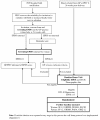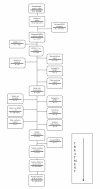The prevalence of suicidal ideation identified by the Edinburgh Postnatal Depression Scale in postpartum women in primary care: findings from the RESPOND trial
- PMID: 21812968
- PMCID: PMC3161003
- DOI: 10.1186/1471-2393-11-57
The prevalence of suicidal ideation identified by the Edinburgh Postnatal Depression Scale in postpartum women in primary care: findings from the RESPOND trial
Abstract
Background: Suicide is a leading cause of perinatal maternal deaths in industrialised countries but there has been little research to investigate prevalence or correlates of postpartum suicidality. The Edinburgh Postnatal Depression Scale is widely used in primary and maternity services to screen for perinatal depressive disorders, and includes a question on suicidal ideation (question 10). We aimed to investigate the prevalence, persistence and correlates of suicidal thoughts in postpartum women in the context of a randomised controlled trial of treatments for postnatal depression.
Methods: Women in primary care were sent postal questionnaires at 6 weeks postpartum to screen for postnatal depression before recruitment into an RCT. The Edinburgh Postnatal Depression Scale (EPDS) was used to screen for postnatal depression and in those with high levels of symptoms, a home visit with a standardised psychiatric interview was carried out using the Clinical Interview Schedule-Revised version (CIS-R). Other socio-demographic and clinical variables were measured, including functioning (SF12) and quality of the marital relationship (GRIMS). Women who entered the trial were followed up for 18 weeks.
Results: 9% of 4,150 women who completed the EPDS question relating to suicidal ideation reported some suicidal ideation (including hardly ever); 4% reported that the thought of harming themselves had occurred to them sometimes or quite often. In women who entered the randomised trial and completed the EPDS question relating to suicidal ideation (n = 253), suicidal ideation was associated with younger age, higher parity and higher levels of depressive symptoms in the multivariate analysis. Endorsement of 'yes, quite often' to question 10 on the EPDS was associated with affirming at least two CIS-R items on suicidality. We found no association between suicidal ideation and SF-12 physical or mental health or the EPDS total score at 18 weeks.
Conclusions: Healthcare professionals using the EPDS should be aware of the significant suicidality that is likely to be present in women endorsing 'yes, quite often' to question 10 of the EPDS. However, suicidal ideation does not appear to predict poor outcomes in women being treated for postnatal depression.
Trial registration: Current Controlled Trials ISRCTN16479417.
Figures


References
-
- Lewis G, (ed) The Confidential Enquiry into Maternal and Child Health (CEMACH). Saving Mothers' Lives: reviewing maternal deaths to make motherhood safer - 2003-2005. The Seventh Report on Confidential Enquiries into Maternal Deaths in the United Kingdom. London: CEMACH; 2007.
-
- Austin MP, Kildea S, Sullivan E. Maternal mortality and psychiatric morbidity in the perinatal period: challenges and opportunities for prevention in the Australian setting. Med J Aust. 2007;186:364–367. - PubMed
-
- Moller HJ. Suicide, suicidality and suicide prevention in affective disorders. Acta Psychiatr Scand. 2003;418:73–80. - PubMed
-
- Bernal M, Haro JM, Bernert S, Brugha T, de Graaf R, Bruffaerts R, Lépine JP, de Girolamo GE, Vilagut G, Gasquet I, Torres JV, Kovess V, Heider D, Neeleman J, Kessler R, Alonso J. Risk factors for suicidality in Europe: Results from the ESEMED study. J Affect Disorders. 2007;101:27–34. doi: 10.1016/j.jad.2006.09.018. - DOI - PubMed
Publication types
MeSH terms
Associated data
LinkOut - more resources
Full Text Sources
Medical

